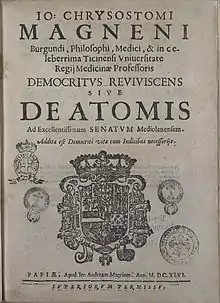Johann Chrysostom Magnenus
Johann Chrysostom Magnenus (French Jean Chrysostôme Magnen, c. 1590 – c. 1679[1]) was a physician and advocate of atomism.
He was born at Luxeuil in Burgundy.[2] He took a medical degree at the University of Dôle.[3]

He joined the medical faculty at the University of Pavia, where he published his scientific work Democritus reviviscens in 1646. He cited Daniel Sennert, but his ideas were distinct from Sennert's and those of Democritus. He considered that atoms were the indivisible parts of three of the classical elements: earth, water and fire.[4] In 1646, Magnenus estimated a lower bound for the number of atoms in a piece of incense "not larger than a pea". [5] His value of 7.776 × 10^17 is off by a factor of one million, but that is still quite impressive as the modern value was not determined until 1865 by Josef Loschmidt.
His other writings include De tabaco (1648), on medical usage and effects of tobacco, and De manna liber singularis (1648). He apparently prescribed tobacco syrup as a standard remedy for his patients.
References
- these are the dates given in Dictionary of Scientific Biography; Güsgens (1910) estimated his birth at close to 1600 and his death close to 1670.
- "The Galileo Project". galileo.rice.edu. Retrieved 2018-11-20.
- Francesco Bottin, Models of the History of Philosophy: From its origins in the Renaissance to the "historia philosophica" (1993), pp. 133–4; Google Books.
- Daniel Garber, Michael Ayers (editors), The Cambridge History of Seventeenth-century Philosophy, Volume 1 (2003), p. 556; Google Books.
- "The Concept of Law and Models in Chemistry". cambridge.org. Retrieved 2019-06-20.
- J. Güsgens, Die Naturphilosophie des Johannes Chryostomos Magnenus, Bonn, 1910.